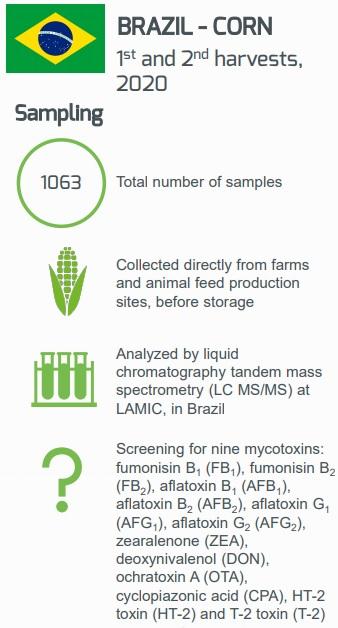Mycotoxin Contamination in Brazilian Corn harvested in 2020
Published: December 15, 2020
By: Margaux Lecolinet, Global Marketing Manager Mycotoxins Management. Julia Dvorska, Global Scientific & Technical Manager Mycotoxin Management
Corn from the two 2020 harvests was found to have low to medium levels of five mycotoxins: AFB1, FB1, ZEA, DON and NIV (multiple mycotoxin contamination). The possible synergism, or additive effect of mycotoxins, also needs to be considered. Multiple mycotoxins at low to medium levels can have negative effects on animal health, reproduction and performance.
Based on the results of this survey, the 2020 Brazilian corn crop should not automatically be considered safe for inclusion in finished feed rations for all animal species. Special attention should be paid to the medium-level average concentration of FB1 (1275 μg/kg), which was found in 80% of the samples, with a maximum concentration of 16,614 μg/kg. According to the risk assessment table, the average DON and NIV level pose a low to medium risk to sensitive animals as piglets, sows, boars and horses. AFB1 was detected at an average of 6 μg/kg, which represents a medium risk for dairy cows. ZEA levels were low, indicating a low risk to animal health and performance.
In view of the detected mycotoxins and their levels, there is a greater probability of observing negative effects of the mycotoxin cocktail (FB1, AFB1, ZEA, DON and NIV) when rations are made of more than 50% corn.
The results of Adisseo’s 2020 analysis of newly harvested corn in Brazil show that, in terms of mycotoxin contamination, the quality of this year’s harvest is cause for concern. However, supplementing animal feed with Mycotoxin Management products is an effective strategy for preventing the negative effects of mycotoxins on animal health and performance.
The key outcomes are:
- 80% of the samples contaminated with #mycotoxins
- Fumonisins have the highest occurence followed by Zearalenone, Aflatoxin B1, Nivalenol and Deoxynivalenol
- Overall the level of contamination are low to medium
- Multiple contamination could lead to observe negative effects on #AnimalHealth and performance when rations are made of more than 50% corn.

Mycotoxin contamination in newly harvested grain is a very important parameter to consider. That grain is used to feed the animals for the whole year, until the next harvest. As the saying goes, “knowing the enemy is half the battle won.” In turn, if we know the level of contamination, we can think about the best use of the wheat: to which animal species can it be fed (avoiding the more sensitive species in cases of high contamination or decreasing the level of wheat in their diet) and which MycoMan Program product should be used to decrease the possible negative effects of contamination on animal performance and health. Read the complete harvest bulletin here
Related topics:
Authors:
Adisseo
Adisseo
Influencers who recommended :
Julia dvorskaRecommend
Comment
Share

Would you like to discuss another topic? Create a new post to engage with experts in the community.







.jpg&w=3840&q=75)